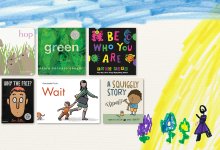- Administration & Leadership
Connecting School Values and Student Well-Being
Aligning your social and emotional learning curriculum with a clear set of values helps students see the relevance and importance of those lessons.Your content has been saved!
Go to My Saved Content. - Student Engagement
5 Simple-to-Play Indoor Classroom Games
When the weather outside is frightful, the right activity can transform students’ pent-up energy into laughter, movement, and focus.Your content has been saved!
Go to My Saved Content. - Technology Integration
How to Create Effective 15-Minute SEL Activities
Teachers can use common tech tools to create short social and emotional learning activities that fit easily into classroom routines.Your content has been saved!
Go to My Saved Content. - Brain-Based Learning
Bolstering Effortful Thinking With Think, Ink, Pair, Share
Adding a writing step to this common classroom practice helps teachers ensure that every student is getting the opportunity to think deeply about a question.Your content has been saved!
Go to My Saved Content. - Administration & Leadership
How to Successfully Institute Student-Led Conferences at Your School
A middle school principal on how teachers, students, and families have benefited from an initiative that guides students to take ownership of their learning. - Environmental Education
The Benefits of Nature Journaling in English Class
While observing outdoor settings, students pay attention to specific details and employ critical thinking as they sharpen their writing skills. - Classroom Management
Digital Wellness in the Age of Cell Phone Bans
Although policies can help create structure, they don’t build consistent digital habits—those have to be taught, modeled, practiced, and reflected upon.117Your content has been saved!
Go to My Saved Content. - Student Engagement
5 Ways to Encourage Deep Mathematical Thinking
You can adapt the curriculum you have to create rich tasks that invite reasoning and build students’ problem-solving skills.277Your content has been saved!
Go to My Saved Content. - English Language Learners
Sentence-Level Scaffolds That Foster English Learners’ Independence and Growth
Teachers can structure supports to guide English learners to speak and write using grade-level, discipline-specific language.156Your content has been saved!
Go to My Saved Content. - Differentiated Instruction
6 Strategies to Make Setting Up Small Group Work More Sustainable
Elementary teachers can reap the benefits of differentiated instruction in math by leveraging existing resources.151Your content has been saved!
Go to My Saved Content.
Popular
- Formative Assessment
13 Super-Quick Formative Assessments
Teachers can use these techniques to gauge students’ understanding mid-lesson and then decide whether to reteach or press ahead. - Student Engagement
3 Ways to Prime Students’ Brains for Achievement
Using priming language is a powerful way to set the stage for learning, and we’ve got a free downloadable word bank here to help you implement this research-backed strategy. - Teaching Strategies
Concrete, Pictorial, Abstract: Using the CPA Method in Upper Elementary Math
Teachers can help students build deeper math understanding and confidence by introducing concepts in distinct stages. - Research
5 Research-Backed Ways to Build Better Readers
The latest research on five foundational strategies that are teacher-tested and grounded in science.554Your content has been saved!
Go to My Saved Content. - Media Literacy
5 Ways to Build Critical Literacy in the Age of AI
With so much information—and misinformation—coming at them every day, students need to learn how to verify truth.
- Place-Based Learning
Boosting Midyear Engagement With Place-Based PBL
High school teachers can build projects around issues in the local community to motivate students before and after winter break.133Your content has been saved!
Go to My Saved Content. - Project-Based Learning (PBL)
Making Project-Based Learning More Impactful by Emphasizing Depth Over Speed
Teachers can help students get the most out of PBL by focusing on the development of effective learning habits.191Your content has been saved!
Go to My Saved Content. - Project-Based Learning (PBL)
Bringing Together Cosplay and Coding in High School
In this class, students learn engineering skills as well as costume design and event planning, culminating in a convention that’s open to the whole community. - Project-Based Learning (PBL)
10 National Parks Service Resources Every Teacher Should Know About
Teachers can explore these lesson plans, websites, and other resources to enhance project-based learning units that incorporate a variety of subjects.1.1kYour content has been saved!
Go to My Saved Content. - Project-Based Learning (PBL)
A Moviemaking PBL Experience Brings History to Life
Middle school students can create short films to demonstrate learning, bringing historical events such as the Boston Tea Party to life.363Your content has been saved!
Go to My Saved Content.
- Literacy
Boosting Preschool Students’ Language Skills Through Art and Nature
Teachers can gently embed language development into everyday sensory moments in the classroom. - Research
5 Research-Backed Ways to Build Better Readers
The latest research on five foundational strategies that are teacher-tested and grounded in science.554Your content has been saved!
Go to My Saved Content. - Literacy
A Simple and Effective Way to Teach Annotation
Try a straightforward three-step strategy to help students get comfortable with exploring challenging reading assignments.522Your content has been saved!
Go to My Saved Content. - Literacy
Using Picture Books to Support Meaning-Making in the Early Grades
Early childhood teachers can guide students in exploring how to communicate meaningful events and feelings even before they can write.211Your content has been saved!
Go to My Saved Content. - Literacy
Adding Movement to Phonics Instruction
By providing strategies that combine letter sounds with motions, teachers help students learn to decode words in the ways that work best for them.Your content has been saved!
Go to My Saved Content.
- Administration & Leadership
How to Create a Thriving Drop-In Culture
With deliberate planning and a low-stakes approach, peer drop-in initiatives offer inspiring, expert professional development without leaving the school building.168Your content has been saved!
Go to My Saved Content. - New Teachers
5 Strategies to Help Build Math Fluency in K–2
Teachers can move beyond flashcards to give young students a lot of practice in developing a key math skill.329Your content has been saved!
Go to My Saved Content. - Administration & Leadership
How Administrators and Veteran Educators Can Team Up to Mentor New Teachers
School leaders can support their new teachers by setting up a structured series of discussions and classroom observation sessions.291Your content has been saved!
Go to My Saved Content. - Curriculum Planning
Fresh Approaches to Instructional Design
An educator with 20-plus years of experience on crafting creative and energizing lessons.464Your content has been saved!
Go to My Saved Content. - New Teachers
3 Pieces of Advice for New Teachers
At the heart of these tips from a veteran is the necessity of developing flexibility in managing change in the classroom.568Your content has been saved!
Go to My Saved Content.




























